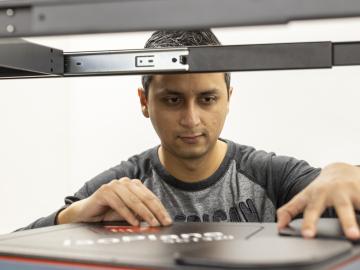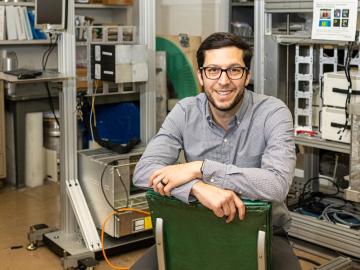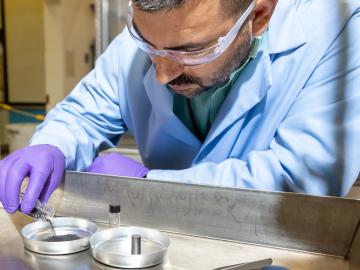
Filter News
Area of Research
- (-) Materials (52)
- (-) Nuclear Science and Technology (28)
- Advanced Manufacturing (14)
- Biological Systems (1)
- Biology and Environment (23)
- Building Technologies (1)
- Computational Biology (2)
- Computer Science (1)
- Energy Science (96)
- Energy Sciences (1)
- Fusion and Fission (21)
- Fusion Energy (9)
- Isotopes (22)
- Materials for Computing (4)
- National Security (5)
- Neutron Science (22)
- Nuclear Systems Modeling, Simulation and Validation (1)
- Quantum information Science (1)
- Supercomputing (22)
News Type
News Topics
- (-) 3-D Printing/Advanced Manufacturing (11)
- (-) Biomedical (5)
- (-) Energy Storage (14)
- (-) Isotopes (10)
- (-) Nuclear Energy (37)
- (-) Physics (15)
- (-) Space Exploration (5)
- Advanced Reactors (9)
- Artificial Intelligence (4)
- Big Data (2)
- Bioenergy (3)
- Buildings (2)
- Chemical Sciences (12)
- Clean Water (3)
- Composites (6)
- Computer Science (10)
- Coronavirus (3)
- Critical Materials (5)
- Cybersecurity (1)
- Environment (7)
- Exascale Computing (1)
- Fusion (12)
- Grid (2)
- High-Performance Computing (1)
- Machine Learning (2)
- Materials (32)
- Materials Science (41)
- Mathematics (1)
- Microscopy (14)
- Molten Salt (5)
- Nanotechnology (18)
- Neutron Science (17)
- Partnerships (3)
- Polymers (11)
- Quantum Computing (2)
- Quantum Science (1)
- Security (1)
- Summit (1)
- Transportation (10)
Media Contacts

Oak Ridge National Laboratory researchers working on neutron imaging capabilities for nuclear materials have developed a process for seeing the inside of uranium particles – without cutting them open.

A software package, 10 years in the making, that can predict the behavior of nuclear reactors’ cores with stunning accuracy has been licensed commercially for the first time.

The techniques Theodore Biewer and his colleagues are using to measure whether plasma has the right conditions to create fusion have been around awhile.

The formation of lithium dendrites is still a mystery, but materials engineers study the conditions that enable dendrites and how to stop them.

Scientists at have experimentally demonstrated a novel cryogenic, or low temperature, memory cell circuit design based on coupled arrays of Josephson junctions, a technology that may be faster and more energy efficient than existing memory devices.

Researchers at Oak Ridge National Laboratory demonstrated that an additively manufactured polymer layer, when applied to carbon fiber reinforced plastic, or CFRP, can serve as an effective protector against aircraft lightning strikes.

As scientists study approaches to best sustain a fusion reactor, a team led by Oak Ridge National Laboratory investigated injecting shattered argon pellets into a super-hot plasma, when needed, to protect the reactor’s interior wall from high-energy runaway electrons.

If humankind reaches Mars this century, an Oak Ridge National Laboratory-developed experiment testing advanced materials for spacecraft may play a key role.

Jason Nattress, an Alvin M. Weinberg Fellow at the Department of Energy’s Oak Ridge National Laboratory, found his calling on a nuclear submarine.

Ask Tyler Gerczak to find a negative in working at the Department of Energy’s Oak Ridge National Laboratory, and his only complaint is the summer weather. It is not as forgiving as the summers in Pulaski, Wisconsin, his hometown.


